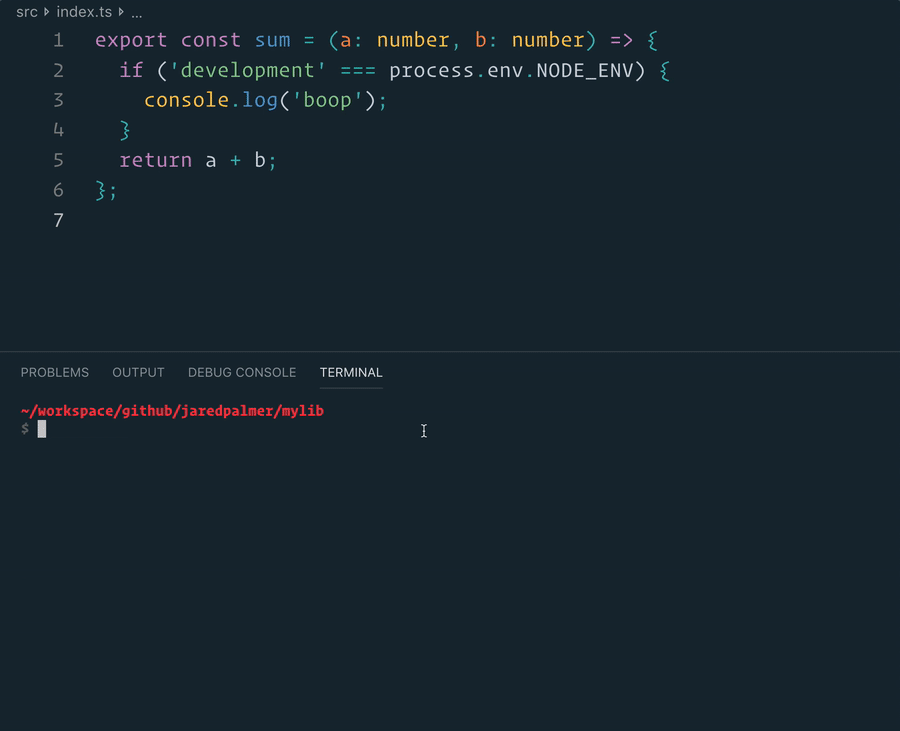Despite all the recent hype, setting up a new TypeScript (x React) library can be tough. Between Rollup, Jest, tsconfig, Yarn resolutions, TSLint, and getting VSCode to play nicely....there is just a whole lot of stuff to do (and things to screw up). TSDX is a zero-config CLI that helps you develop, test, and publish modern TypeScript packages with ease--so you can focus on your awesome new library and not waste another afternoon on the configuration.
TSDX comes with the "battery-pack included" and is part of a complete TypeScript breakfast:
- Bundles your code with Rollup and outputs multiple module formats (CJS & ESM by default, and also UMD if you want) plus development and production builds
- Comes with treeshaking, ready-to-rock lodash optimizations, and minification/compression
- Live reload / watch-mode
- Works with React
- Human readable error messages (and in VSCode-friendly format)
- Bundle size snapshots
- Jest test runner setup with sensible defaults via
tsdx test - Zero-config, single dependency
npx tsdx create mylib
cd mylib
yarn start
That's it. You don't need to worry about setting up Typescript or Rollup or Jest or other plumbing. Just start editing src/index.ts and go!
Below is a list of commands you will probably find useful:
Runs the project in development/watch mode. Your project will be rebuilt upon changes. TSDX has a special logger for your convenience. Error messages are pretty printed and formatted for compatibility VS Code's Problems tab.
Your library will be rebuilt if you make edits.
Bundles the package to the dist folder.
The package is optimized and bundled with Rollup into multiple formats (CommonJS, UMD, and ES Module).
Runs the test watcher (Jest) in an interactive mode. By default, runs tests related to files changed since the last commit.
Runs Eslint with Prettier on .ts and .tsx files.
If you want to customize eslint you can add an eslint block to your package.json, or you can run yarn lint --write-file and edit the generated .eslintrc.js file.
Aside from just bundling your module into different formats, TSDX comes with some optimizations for your convenience. They yield objectively better code and smaller bundle sizes.
After TSDX compiles your code with TypeScript, it processes your code with 3 Babel plugins:
babel-plugin-annotate-pure-calls: Injects for#__PUREannotations to enable treeshakingbabel-plugin-dev-expressions: A mirror of Facebook's dev-expression Babel plugin. It reduces or eliminates development checks from production codebabel-plugin-rename-import: Used to rewrite anylodashimports
babel-plugin-annotate-pure-calls + babel-plugin-dev-expressions work together to fully eliminate dead code (aka treeshake) development checks from your production code. Let's look at an example to see how it works.
Imagine our source code is just this:
// ./src/index.ts
export const sum = (a: number, b: number) => {
if (process.env.NODE_ENV !== 'production') {
console.log('Helpful dev-only error message');
}
return a + b;
};tsdx build will output an ES module file and 3 CommonJS files (dev, prod, and an entry file). If you want to specify a UMD build, you can do that as well. For brevity, let's examine the CommonJS output (comments added for emphasis):
// Entry File
// ./dist/index.js
'use strict';
// This determines which build to use based on the `NODE_ENV` of your end user.
if (process.env.NODE_ENV === 'production') {
module.exports = require('./mylib.cjs.production.js');
} else {
module.exports = require('./mylib.cjs.development.js');
}// CommonJS Development Build
// ./dist/mylib.cjs.development.js
'use strict';
const sum = (a, b) => {
{
console.log('Helpful dev-only error message');
}
return a + b;
};
exports.sum = sum;
//# sourceMappingURL=mylib.cjs.development.js.map// CommonJS Production Build
// ./dist/mylib.cjs.production.js
'use strict';
exports.sum = (s, t) => s + t;
//# sourceMappingURL=test-react-tsdx.cjs.production.js.mapAS you can see, TSDX stripped out the development check from the production code. This allows you to safely add development-only behavior (like more useful error messages) without any production bundle size impact.
For ESM build, it's up to end-user to build environment specific build with NODE_ENV replace (done by Webpack 4 automatically).
TSDX's rollup config removes getters and setters on objects so that property access has no side effects. Don't do it.
TSDX will use babel-plugin-dev-expressions to make the following replacements before treeshaking.
Replaces
if (__DEV__) {
console.log('foo');
}with
if (process.env.NODE_ENV !== 'production') {
console.log('foo');
}IMPORTANT: To use __DEV__ in TypeScript, you need add declare var __DEV__: boolean somewhere in your project's type path (e.g. ./types/index.d.ts).
// ./types/index.d.ts
declare var __DEV__: boolean;Note: The
dev-expressiontransform does not run whenNODE_ENVistest. As such, if you use__DEV__, you will need to define it as a global constant in your test environment.
Replaces
invariant(condition, argument, argument);with
if (!condition) {
if ('production' !== process.env.NODE_ENV) {
invariant(false, argument, argument);
} else {
invariant(false);
}
}Note: TSDX doesn't supply an invariant function for you, you need to import one yourself. We recommend https://github.com/alexreardon/tiny-invariant.
To extract and minify error codes in production into a static codes.json file, pass an extractErrors flag with a URL where you will decode the error code. Example: tsdx build --extractErrors=https://your-url.com/?invariant=
Replaces
warning(condition, argument, argument);with
if ('production' !== process.env.NODE_ENV) {
warning(condition, argument, argument);
}Note: TSDX doesn't supply a warning function for you, you need to import one yourself. We recommend https://github.com/alexreardon/tiny-warning.
If you want to use a lodash function in your package, TSDX will help you do it the right way so that your library does not get fat shamed on Twitter. However, before you continue, seriously consider rolling whatever function you are about to use on your own. Anyways, here is how to do it right.
First, install lodash and lodash-es as dependencies
yarn add lodash lodash-esNow install @types/lodash to your development dependencies.
yarn add @types/lodash --devImport your lodash method however you want, TSDX will optimize it like so.
// ./src/index.ts
import kebabCase from 'lodash/kebabCase';
export const KebabLogger = (msg: string) => {
console.log(kebabCase(msg));
};For brevity let's look at the ES module output.
import o from"lodash-es/kebabCase";const e=e=>{console.log(o(e))};export{e as KebabLogger};
//# sourceMappingURL=test-react-tsdx.esm.production.js.mapTSDX will rewrite your import kebabCase from 'lodash/kebabCase' to import o from 'lodash-es/kebabCase'. This allows your library to be treeshakable to end consumers while allowing to you to use @types/lodash for free.
Note: TSDX will also transform destructured imports. For example,
import { kebabCase } from 'lodash'would have also been transformed to `import o from "lodash-es/kebabCase".
This feature is still under development
After running --extractErrors, you will have a ./errors/codes.json file with all your extracted error codes. This process scans your production code and swaps out your error message strings for a corresponding error code (just like React!). This extraction only works if your error checking/warning is done by a function called invariant. Note: you can use either tiny-invariant or tiny-warning, but you must then import the module as a variable called invariant and it should have the same type signature.
After that, you will need to host the decoder somewhere (with the URL that you passed in to --extractErrors).
Simple guide to host error codes to be completed
TSDX is ripped out of Formik's build tooling. TSDX is very similar to @developit/microbundle, but that is because Formik's Rollup configuration and Microbundle's internals have converged around similar plugins over the last year or so.
- TSDX includes out-of-the-box test running via Jest
- TSDX includes a bootstrap command and default package template
- TSDX is 100% TypeScript focused. While yes, TSDX does use Babel to run a few optimizations (related to treeshaking and lodash), it does not support custom babel configurations.
- TSDX outputs distinct development and production builds (like React does) for CJS and UMD builds. This means you can include rich error messages and other dev-friendly goodies without sacrificing final bundle size.
Description
Rebuilds on any change
Usage
$ tsdx watch [options]
Options
-i, --entry Entry module(s)
--target Specify your target environment (default web)
--name Specify name exposed in UMD builds
--format Specify module format(s) (default cjs,esm)
--tsconfig Specify your custom tsconfig path (default <root-folder>/tsconfig.json)
--verbose Keep outdated console output in watch mode instead of clearing the screen
-h, --help Displays this message
Examples
$ tsdx watch --entry src/foo.tsx
$ tsdx watch --target node
$ tsdx watch --name Foo
$ tsdx watch --format cjs,esm,umd
$ tsdx build --tsconfig ./tsconfig.foo.jsonDescription
Build your project once and exit
Usage
$ tsdx build [options]
Options
-i, --entry Entry module(s)
--target Specify your target environment (default web)
--name Specify name exposed in UMD builds
--format Specify module format(s) (default cjs,esm)
--extractErrors Specify url for extracting error codes
--tsconfig Specify your custom tsconfig path (default <root-folder>/tsconfig.json)
-h, --help Displays this message
Examples
$ tsdx build --entry src/foo.tsx
$ tsdx build --target node
$ tsdx build --name Foo
$ tsdx build --format cjs,esm,umd
$ tsdx build --extractErrors=https://reactjs.org/docs/error-decoder.html?invariant=
$ tsdx build --tsconfig ./tsconfig.foo.jsonThis runs Jest v24.x in watch mode. See https://jestjs.io for options. If you are using the React template, jest uses the flag --env=jsdom by default.
Description
Run eslint with Prettier
Usage
$ tsdx lint [options]
Options
--fix Fixes fixable errors and warnings
--ignore-pattern Ignore a pattern
--write-file Write the config file locally
-h, --help Displays this message
Examples
$ tsdx lint src
$ tsdx lint src --fix
$ tsdx lint src test --ignore-pattern test/foo.ts
$ tsdx lint src --write-file

